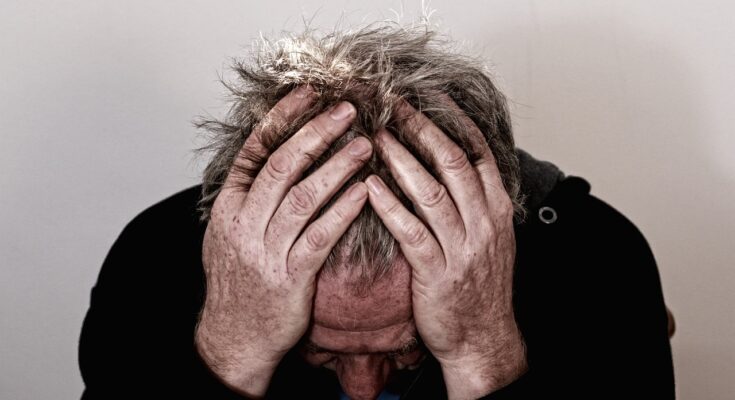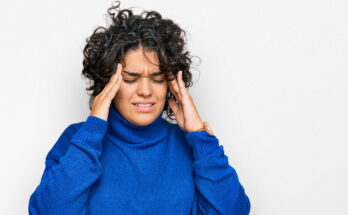What Is Head Pain on Top of Head?
Head pain on the top of head refers to pain or discomfort in the area of the head that is specifically located at the crown or vertex (top) of the skull. This type of head pain (top of head) can be a dull tight pressure, or it can be a sharp, stabbing sensation and can sometimes feel like weight pressing down on top of the head.
Unlike durable frontal headache like sinus headache, or unilateral headaches such as migraine headache, head pain top of head is normally found at the center of the head and is less likely associated with a specific area of your face or neck. Although, it does have associations with tension-type headaches, it may start to come about from several different causes and triggers like posture, fatigue, stress, or a potential more serious issue underlying the head pain on the top of the head.
Determining the reason for this specific type of head pain is of utmost importance for different inputs as it relates to treatment. Most often it is harmless, however it should go without saying that it is always important to get assessed by your health professional if persistent, or in the case of severe pain.

Common Causes of Head Pain on Top of Head
Headache on top of head can be caused by a variety of common reasons. Although it might feel distressing, many of these causes are harmless and easily treated with some changes or habits. The first step to helping you feel better is knowing what might be causing your pain.
- Tension Headaches
Tension headaches are the most common cause of headache on top of head. Commonly felt as a tight band or pressure across the scalp, tension headaches can often be caused by one or more of the following triggers: stress, poor posture, or general fatigue. - Poor Posture
If we sit or stand with bad posture, especially for extended periods, it can lead to muscles being in a shortened position becoming tight and strained, often in neck and upper back. The tension in these muscles can move to the crown and top of head resulting in a dull pain or at best discomfort. - Dehydration
Not drinking enough water can lead to the development of dehydration headaches. Head pain on top of head will be frequently experienced if a person has been exercising or exposed to heat environmental stresses. - Not Sleeping
Lack of sleep generally and/or poor sleep can lead to the development of headaches. When you are sleep deprived this often alters how the brain perceives pain signals making an individual more sensitive to pain signals (meaning pain felt on the crown of head). - Stress and Anxiety
High levels of stress or anxiety can produce muscle tension, which contribute to headaches. Pain is often experienced in the area on top of the head and can range in intensity. - Tension on the Scalp or Tight Hairstyles
Wearing tight braids, ponytails, and hats can place tension on the scalp and lead to head pain on top of head over a period of time if pressure is consistently placed on the same area. - Physical Force
Overexertion during exercise or physical activity can also lead to a throbbing pain at the top of the head following the increased work effort. This is known as an exertional headache, which actually occurs during or after initiation of intense effort.

Serious Causes You Shouldn’t Ignore
In most cases, the causes of head pain on top of head are more likely the result of tension or stress. However, some conditions may be of greater concern for serious underlying issues and should be recognized as uncommon but dangerous.
- Occipital Neuralgia
Occipital neuralgia occurs when the occipital nerves (located in the base of the skull) become irritated or compressed, leading to stabbing and shooting pain, which can often radiate up to the very top of the head. Generally, the pain is confused with a migraine headache but is usually more localized, intense, and easily relieved. - Brain Aneurysm
The pain associated with a ruptured brain aneurysm is very rare, but the first symptom you may feel if you are one of the unlucky few is sudden, severe head pain on the very top of your head, often described as simply the “worst headache of your life.” If your head pain has come on suddenly without a cause and you also notice nausea, confusion, or unconsciousness, seek medical attention immediately. - High Blood Pressure (Hypertension)
Infrequently, uncontrolled high blood pressure can lead to headaches, including pain at the very top of the head. This is more commonly seen in cases of hypertensive crisis and should not be ignored. - Medication Overuse Headache (Rebound Headache)
Taking over-the-counter or prescription pain killers too often can lead to rebound headaches. Rebound headaches can be described as head pain that involves the entire head, including the top, and can become a persistent issue if not recognized and dealt with appropriately. - Head Injury or Concussion
Even a trivial head injury can cause you to feel head pain on the top of the head, especially if there was some swelling or inflammation associated with the injury. If the pain started shortly after a fall or impact, also monitor for any dizziness, memory problems, or nausea.
If you are having sudden intense pain or you are not getting better with rest and hydration, you should talk to a healthcare provider. It is important to see a healthcare provider early to rule out serious injuries and/or conditions and to receive appropriate treatment.
Associated Symptoms to Watch Out For
If you have pain on top of your head and are recognizing it with associated symptoms, you may pinpoint the type of headache or recognize it may warrant a more serious condition. While pain at the top of the head is typically not harmful, the presence of multiple symptoms may indicate a deeper issue.
Here are some common associated symptoms to watch for:
- Pressure or tightness: This dull, squeezing sensation experienced on the crown of there is tension headaches.
- Sharp or stabbing pains: If your head pain suddenly comes on in a sharp, intense pain, may be considered neuralgia or a nerve related problem.
- Pain that is worse with movement: If your pain worsens with frequent bending over, coughing or turning your head, you have increased pain maybe muscle or spinal in nature.
- Tenderness on the scalp: Some individuals will experience soreness on the top of the head when touching the crown. This may indicate an inflammation condition or skin condition.
- Tiredness and brain fog: These usually accompany headache symptoms caused by stress, or by lack of restful sleep.
- Sensitivity to light or sound: Head pain on the top of head with nausea and light sensitivity may be a sign of migraine attack.
- Visual disturbances: Blurred vision or whatlooks like “flashes of light” may be a warning sign and should be assessed by your doctor.
- If any of these symptoms are new, severe, or concern you, have it checked out by your health care provider to rule out anything serious.

When to See a Doctor
In most cases, headaches are not dangerous. However, there are times when you should seek help. Being aware of the signs can help avoid more serious health problems.
Call a physician if you have one or more of these symptoms:
- Sudden, severe pain that is described as the worst headache ever
- Head pain on top of head after a head injury or fall
- Pain with fever, stiff neck, or confusion, potential infection
- Changes in vision, speech, or balance
- Head pain on top of head that does not resolve with rest, or medication, or gets worse
- Head pain on top of head that wakes you or is present each morning
- Numbess, weakness, or tingling that affects your arms, legs, or face
If your headache pain on top of head is affecting your everyday life or not improving with home remedies, or your headache pain on top of head is persisting, get evaluated. A healthcare provider will work with you to find out the cause and recommend treatment.
Home Remedies for Head Pain on Top of Head
If you are suffering from head pain on top of head, there are a few easy home remedies you can try. These remedies can help temporarily relieve pain from mild to moderate that could be caused by tension, fatigue, and/or poor posture.
- Use a cold or warm pack
To help with head pain on top of head that is associated with tension or inflammation, take a cold pack to the pain about 15-20 minutes. If the top of head pain is associated with muscle tightness, then a warm pack or heating pad may work better to help relax the muscles. - Use stretching and neck exercises
Neck and shoulder tension often leads to top of head pain. Gentle stretches and mobility exercises can help relieve this tension and subsequently decrease headache frequency. Try using shoulder rolls, neck tilts, and chin tucks. - Drink fluids
Dehydration is a common and often overlooked cause of head pain on top of head. It is important that you are drinking fluids, especially if you are active and/or in hot environments. - Use over-the-counter medication (on an infrequent basis)
Ibuprofen or acetaminophen can be helpful short-term solutions to head pain on top of head. However, avoid taking these too often because taking them too frequently can lead to rebound headaches. - Control Stress
Stress is a significant catalyst for head pain on top of head. Relaxation features such as deep breathing, meditating, or listening to gentle music can assist with diminishing the stress and head pain from coming back. - Rest in a Calm, Dark Room
Sometimes, rest is the best medicine. Lay down in a calm, dark room to allow your body to rest. Stay away from all technology and loud noises as that could also contribute to head pain. - Improve Your Posture
When slouching over devices you can create strain on muscles that can lead to head pain . So take notice of your posture, especially if you are sitting for long periods and truly pay attention to how you are sitting. Use ergonomic chairs, and have your screen at eye level.
Medical Treatments and Interventions
When looking at managing persistent or severe “pain on top of head,” you want to consider medical management if you’re unable to manage the head pain any longer.
The format of the medical therapy will depend on the diagnosis you get, so evaluation by a medical provider is very important.
For mild to moderate head pain, over-the-counter pain relievers like acetaminophen or ibuprofen usually take the edge off. If you visit the doctor for your frequent head pain problem and you are diagnosed with an episode of migraines, or specific neuralgia, for example, your physician may prescribe medications such as tripatans, or neuralgia medications.
Physical therapy might be helpful, as long as the pain on top of head is not from trauma and surprised you. If you have the pain on top of head related to quality of postures or muscle tension, different techniques such valuable stretching and an exercise program to create strengthening movement may relieve the tension on your nerves and assist with blood flow.
Sometimes medical interventions like trigger point injections or nerve blocks may be recommended in cases of muscle tension on the top of your head. The injections help reduce inflammation and block potential pain signals in the nerves that run on top of the head.
Always consult your doctor before you initiate any treatment, e.g., if your head pain on top of head is more frequent, worsening, or concerning other symptoms like dizziness or vision changes, you should see your doctor. Getting proper medical attention to ensure the best way for you to get relief from your pain as safely and effectively as possible is crucial.
Lifestyle Changes for Prevention
In order to reduce head pain on the top of the head, it begins with making fairly simple changes to lifestyle habits. These changes can reduce the frequency and severity of headaches and improve your quality of life.
- Maintain Good Sleep Hygiene
Poor sleep or varied sleep patterns are common reasons for head pain on top of the head. Aim for 7-8 hours of sleeping every night, and try to be consistent with the bedtime. - Improve Your Posture
For people who sit at a desk for many hours or look down at a phone for long periods of time, poor posture and muscle strain on your neck and scalp can lead to tension which can tip off a headache on the top of the head. Consider upgrading your workspace ergonomically to avoid poor posture, stretching, or taking breaks to stretch for a few minutes. - Manage Stress
Stress is a common cause of tension headaches, which often is symbolized through pain on the top of the head. Incorporate various stress-relieving techniques into your daily life, such as meditation, yoga or deep breathing exercises. - Stay Hydrated
Dehydration can be an unrecognized cause of head pain on top of head, and a relatively frequent trigger for others. Staying hydrated throughout the day by drinking water can prevent headaches due to insufficient fluid intake. - Regular Exercise
As long as the physical activity is not too vigorous, fairly moderate exercise can improve blood flow and circulation, and decrease muscle tension – thus reducing the chances of headaches. Do activities you like to do, and aim for a minimum of 30 minutes most of the time. - Avoid Triggers
Some foods, caffeine, alcohol, and/or skipping meals can trigger headaches in some folks. A headache diary can help you figure out if you have any personal triggers, and then you can avoid those triggers.
Lifestyle changes can decrease the likelihood of having episodes of head pain top of head. You may also improve your quality of life in general.
FAQs About Head Pain on Top of Head
If you are experiencing pain on top of head, pain on top of head might leave you with some simple questions.
Here are some answers to common questions to help you understand what you might be experiencing:
- Can anxiety cause head pain on top of head?
Yes, anxiety can become manifest as tension headache, which can result in pain on the top of the head. When we are anxious we physically can tense our muscles around our scalp and neck and this can lead to discomfort/achiness on top of the head. - Is head pain on top of head dangerous?
In most cases, head pain on top of head is not dangerous and related to tension, ineffective posture related to head and neck positioning, or mild conditions. With that said, if head pain suddenly appears, if it is very severe, or if you develop other symptoms such as changes in vision, weakness, or confusion, get medical attention immediately! - Can head pain on top of head be triggered by dehydration?
Yes, dehydration can be a common trigger for headache, including head pain on the top of the head. When our bodies do not have enough fluids, it can narrow blood vessels and reduce oxygen to the brain and can lead to headache pain. - What can I do to relieve head pain top of head at home?
There are some simple little home remedies to ease head pain on top of head, such as resting in a darkened room, applying a cold pack or warm compress, drinking enough water, and using relaxation techniques. - When should I see a doctor for head pain top of head?
If your head pain on top of head is happening regularly, is severe, and/or is combined with nausea, vomiting, dizziness or neurological symptoms; you should contact your health-care provider for further and proper diagnosis and treatment.
Final Thoughts
Head pain on top of head can vary from mild and temporary to a sign of something more ominous or serious. Knowing the potential causes of head pain—ranging from tension and posture to persistent underlying medical conditions—can help navigate your way to some relief.
Even though in many scenarios it may only take rest, hydration, and stress management to improve the symptoms of head pain on top of head, you should never ignore the persistent or severe head pain on top of head.
It is beneficial to speak to a healthcare professional when:
• Your symptoms are repetitive.
• Your symptoms are becoming more frequent.
• Your body is giving you signals that should not be ignored (see below for warning signs).
Caring for your overall health, being aware of your triggers, and getting timely medical advice will help ensure successful management of head pain on top of head.
Conclusion
Handling head pain on top of head can be uncomfortable, annoying, and sometimes worrying. Thankfully, usually, head pain on top of head is due to manageable causes; such as posture, stress, or tension. Still, it is important to listen to your body—if either the frequency or intensity is strong, repetitive, or there are warning signs (such as other symptoms accompanying the pain), it is safest to contact your doctor.
Once you have a better understanding of the potential causes, recognized warning signs, and both medical and home remedies that may help, you will feel better prepared to take control of your symptoms and potentially improve your quality of life. Don’t let head pain on top of head keep bothering you—dealing with it earlier on gives you the best chance of reducing your pain and improving your health.





